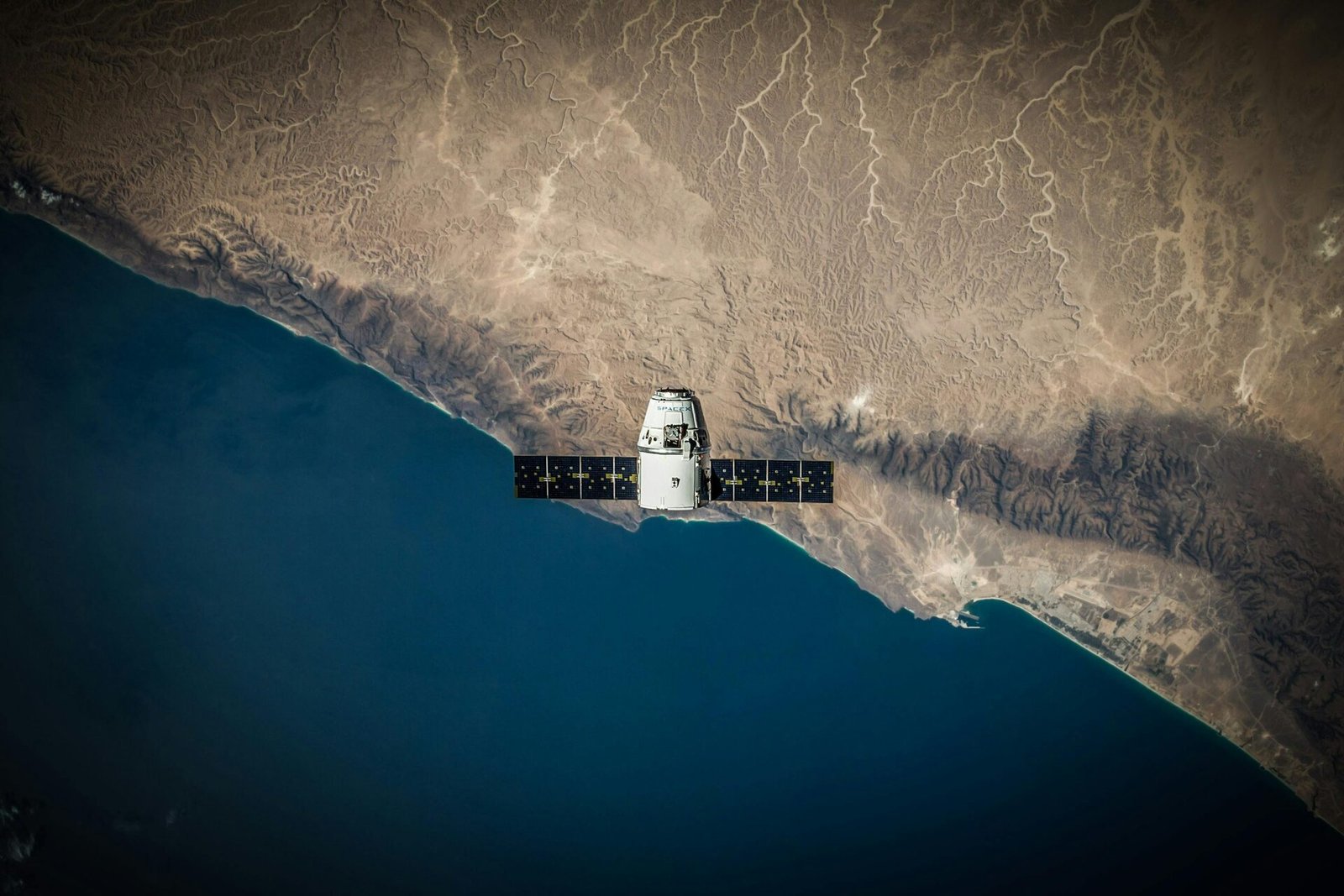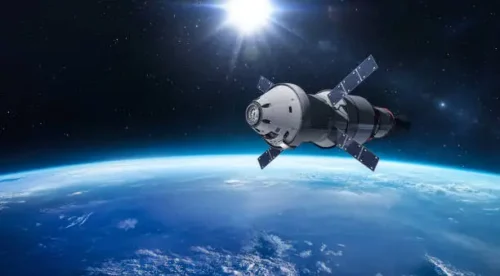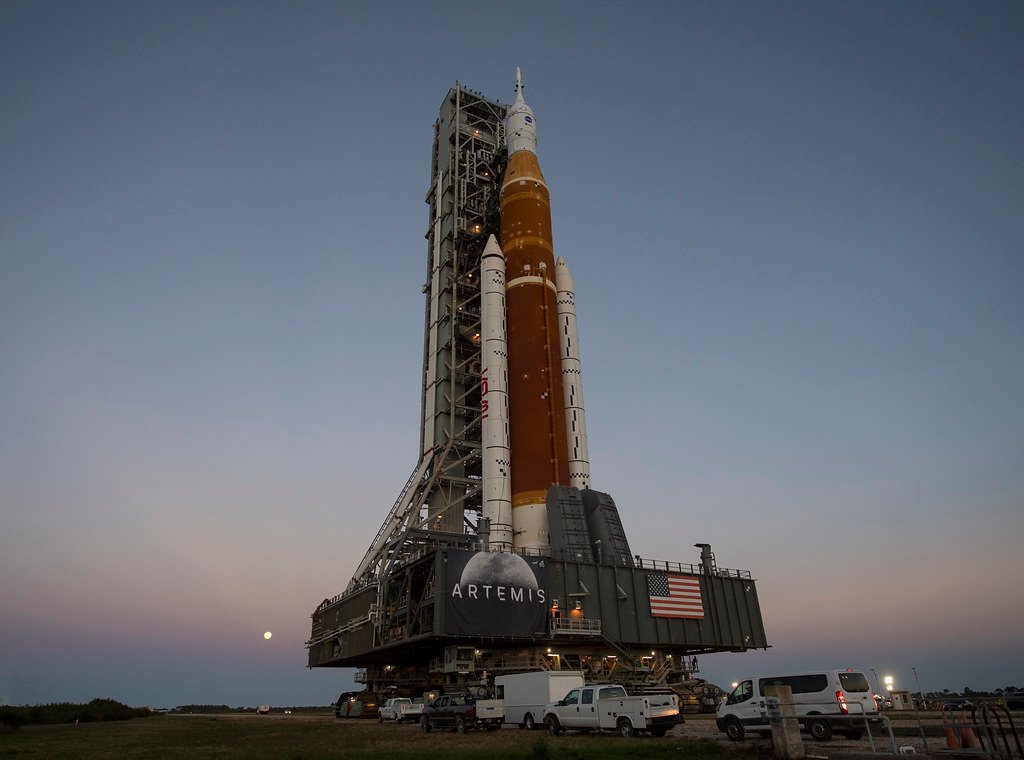Table of Contents
Introduction on Earth Orbit
What does it mean to be in orbit around Earth? From space stations to GPS networks, Earth orbits are crucial to our modern world. Every weather report, satellite TV signal, and long-distance communication depends on objects circling our planet in precisely calculated paths. But how exactly do these satellites stay up there? This article explores the physics behind Earth orbit, the types of orbits satellites can follow, how they get there, and what this means for our technology and future in space.
What Is an Earth Orbit?
An Earth orbit is the curved path a satellite follows as it moves around Earth under the influence of gravity. Objects in orbit are constantly falling toward Earth due to gravity, but they also move forward fast enough that they keep missing it. This balance between downward pull and forward motion creates a stable path—an orbit (check also How Do Satellites Stay in Orbit? A Beginner’s Guide
The concept may seem abstract, but a simple analogy helps: imagine swinging a ball on a string around your head. The string pulls inward (like gravity), and the ball moves forward in a circular path. Remove the string, and the ball flies off in a straight line. The same principle applies to satellites—gravity keeps them from flying away, but their momentum keeps them from falling straight down.
Historically, Johannes Kepler was the first to describe planetary motion through his three laws. Later, Isaac Newton explained that the same force governing an apple’s fall also governs the motion of the Moon—gravity.
The Physics of Staying in Orbit
Gravity vs. Inertia
At the core of any orbit is a delicate balance between two forces: gravity and inertia. Gravity pulls the satellite toward Earth. Inertia, instead is the tendency of an object to move in a straight line, keeps the satellite moving forward. When these two forces are in equilibrium, the satellite follows a curved path around Earth.
Centripetal Force
In orbital motion, gravity acts as the centripetal force, constantly pulling the satellite toward Earth and keeping it in a curved trajectory. The centripetal force needed to maintain a circular orbit is given by:
![]()
where:
- m: is the mass of the satellite,
- v: is the orbital velocity,
- r: is the radius of the orbit from Earth’s center.
Gravitational Force
This is balanced by the gravitational force between Earth and the satellite, given by Newton’s law of universal gravitation:
![]()
where:
- G: is the gravitational constant,
- M: is Earth’s mass,
- r: is the distance from Earth’s center,
- m: is the satellite’s mass.
Equating the two forces yields the orbital velocity:
![]()
(1) ![]()
Orbital Period
The time it takes for a satellite to complete one orbit is its orbital period, ![]() , which can be derived considering that the relation between angular velocity and tangent speed is the following (see also the figure below):
, which can be derived considering that the relation between angular velocity and tangent speed is the following (see also the figure below):
![]()
Where ![]() is the angular velocity and it is computed in
is the angular velocity and it is computed in ![]() . Therefore, the satellite to complete one orbit needs:
. Therefore, the satellite to complete one orbit needs:
(2) ![]()
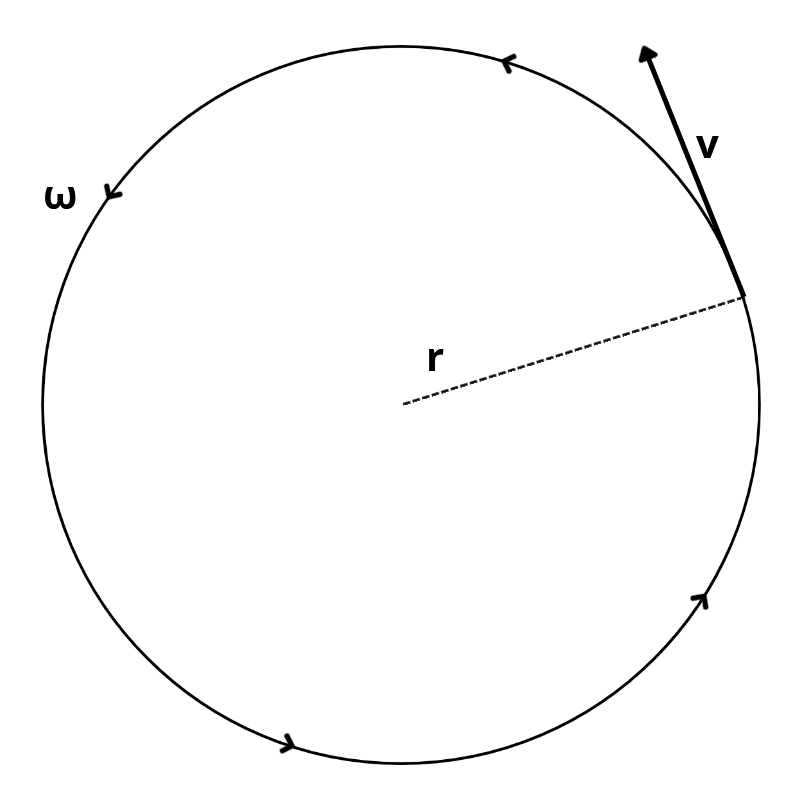
Substituting equation (1) in equation (2), we can find:
(3) ![]()
This formula helps mission planners determine the necessary speed and altitude to achieve specific orbit durations, assuming that the orbit is circular. Please, check also the orbital calculator below.
Orbital Period Calculator
Valid for satellites in circular orbit around Earth.
Types of Earth Orbits
Low Earth Orbit (LEO)
- Altitude: 300 to 2000 km
- Orbital Period: ~90 minutes
- Velocity: ~7.8 km/s
- Uses: Earth observation, International Space Station (ISS), reconnaissance, remote sensing, and some communication satellites
LEO is ideal for missions requiring low latency and high-resolution imaging. The ISS orbits at around 400 km, completing a revolution every 92 minutes. Earth observation satellites in LEO are often placed in Sun-synchronous orbits.
✅ Advantages:
- Problems related to atmospheric drag and Van Allen radiation belt;
- low temporal resolution, since the satellite is quite fast.
❌ Disadvantage:
- High spatial resolution, in other words it is possible to zoom more on ground;
- polar coverage, possibility to have satellite orbits with very high inclination to cover poles.
Medium Earth Orbit (MEO)
- Altitude: 2,000 to 35,786 km
- Orbital Period: 2 to 12 hours
- Velocity: ~3.9–7.0 km/s
- Uses: GPS, Galileo, GLONASS, BeiDou navigation systems
This type of orbit has the characteristic to pass over a certain point periodically.
Navigation satellites need to orbit high enough for wide coverage but low enough to ensure signal strength and manageable latency. In addition, this type of orbit is not disturbed by atmospheric drag.
This is why GPS costellation was born. The constellation is constitued using 24 satellites in 6 differnt orbital planes. They have a period of revolution of approximately 12 hours.
✅ Advantages:
- Not disturbed by atmospheric drug
- Wide area coverage with respect to LEO
- Lower latency with respect to GEO
❌ Disadvantages:
- More expensive than LEO in terms of cost (due to higher altitude)
- Limited payload size
- Radiation exposure (e.g. Van Allen radiation belt)
Geostationary Orbit (GEO)
- Altitude: ~35,786 km
- Orbital Period: 24 hours
- Velocity: ~3.1 km/s
- Uses: Weather monitoring, satellite television, communications
A satellite in GEO appears stationary over the equator. This fixed position is perfect for services needing constant connectivity over a specific region.
Additionally, it is possible to understand the differences between a Geostationary Orbit and a Geosynchronous Orbit.
✅ Advantages:
- Orbit is stationary with respect to on-ground Earth position
- High temporal resolution
- Satellite is always visible (communication) and can be used to estimate atmosphere evolution (weather)
❌ Disadvantages:
- Very expansive launch
- Reduced spatial resolution (due to high) distance
- Bad coverage on high latitude (>60°)
Highly Elliptical Orbits (HEO)
These orbits have:
- low perigees (closest point to Earth, often a few hundred to a few thousand kilometers)
- high apogees (farthest point from Earth, typically over 35 000 km and sometimes beyond 40 000 km),
- An eccentricity significantly greater than zero (often > 0.6)
- A common orbital inclination of ~63.4°
✅ Advantages:
- Long dwell time over target area (at apogee)
- High-latitude coverage
- lower launch energy than GEO
❌ Disadvantages:
- Radiation exposure (HEO passes through Van allen belts)
- Complexity on Ground Station management (since satellites are not geostationary)
- Variable Latency and Signal Strength
Polar and Sun-Synchronous Orbits
A Polar Orbit is a type of Low Earth Orbit (LEO) where the satellite travels in a nearly north-south direction over the poles. As Earth rotates eastward beneath the satellite, each pass allows it to scan a different longitudinal slice of the planet.
- Inclination: ~90°
- Altitude: Typically 500–1 000 km
- Coverage: Global over time (entire Earth surface)
✅ Advantages:
- Enables complete global coverage over multiple orbits.
- Ideal for Earth observation, weather monitoring, reconnaissance, and scientific missions.
- Allows imaging of polar regions, which GEO and many inclined orbits cannot effectively reach.
❌ Disadvantages:
- Limited Revisit Frequency (without constellation)
- Communication Challenges at High Latitudes (ecause the satellite moves quickly and ground stations must track passes that occur for only a few minutes per orbit)
- Disturbed by atmospheric drag
How Satellites Enter and Maintain Earth Orbit
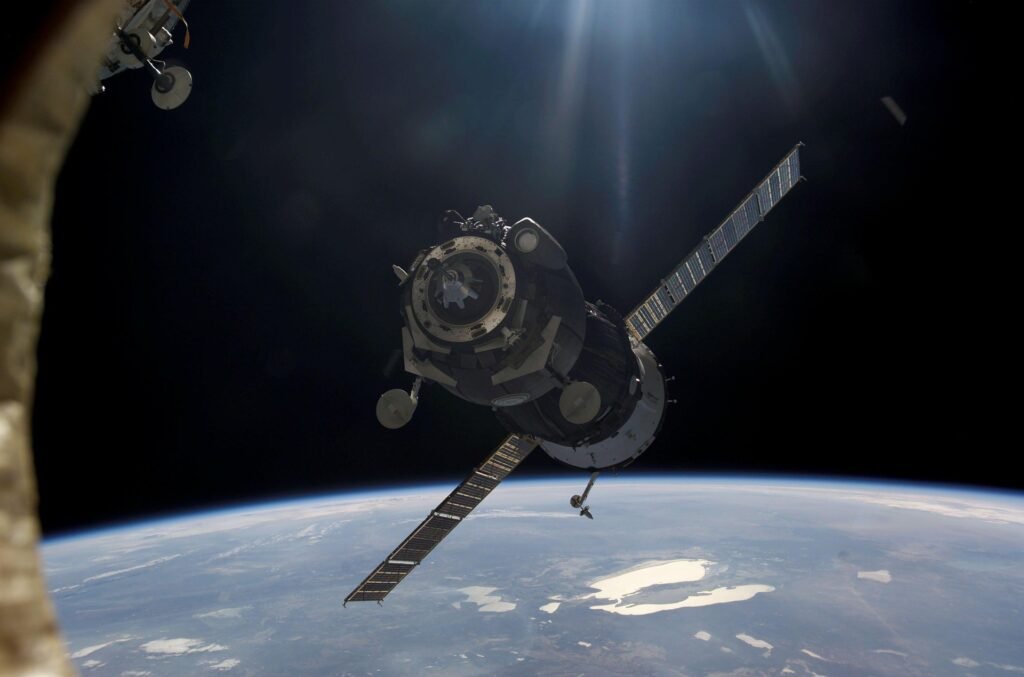
Rocket Launch and Escape velocity
To enter into a orbit, the first step for a satellite is to escape Earth’s gravitational field. To reach orbit, a satellite must be accelerated. This is achieved via multistage rockets that discard spent fuel tanks to become lighter.
In the future we are going to discover the Rocket equation in detail. Anyway for today, let’s assume that no atmospheric drag is present and the propulsion is applicable only at launch.
The energy required to reach orbit is a combination of kinetic and potential energy:
![]()
- m is the object mass
- M is the mass of Earth

- G is the gravitational constant

- R is the Earth’s radius

To escape to Earth’s gravity, we should reach and Energy equal to zero, which means that we are able to compensate the effect of the gravity, using the kinetic Energy. Therefore, we are assuming right now that the satellite just barely escapes Earth’s gravity. From equation (4), it is possible to consider ![]() :
:
![]()
Solving for ![]()
![]()
![]()
This calculation ensures that a satellite has enough energy to resist gravitational pull without escaping it entirely.
Inclination for Earth’s orbits
Launches must be timed precisely to reach desired orbits. Inclination (angle relative to the equator) affects coverage—polar orbits allow full Earth scanning, while equatorial orbits are optimal for GEO.
When a rocket is launched, it follows a trajectory that initially lies close to a great circle path on a spherical Earth. The plane of this trajectory defines the orbital plane. The inclination of the orbit depends on how this plane intersects the Earth’s equator.
The fundamental relation is (it will be analysed deeper in other articles):
![]()
Where:
- i: orbital inclination
 : launch site latitude (positive in Northern Hemisphere)
: launch site latitude (positive in Northern Hemisphere) : launch azimuth (angle clockwise from true north; 90° is due east)
: launch azimuth (angle clockwise from true north; 90° is due east)
The core concept is that you can only launch into orbits with inclinations greater than or equal to the latitude of your launch site.
Orbital Insertion and Speed to maintain Earth’s Orbit
Orbital insertion is the maneuver that places a spacecraft into a stable orbit around a planet. This usually occurs after the launch vehicle has delivered the spacecraft to the correct altitude and velocity. In general, the following steps shall be ensured:
- Launch and ascent into a suborbital trajectory.
- Circularization burn (or insertion burn) at apogee to increase perigee and stabilize the orbit.
- This will result in a closed, elliptical or circular orbit where the spacecraft continuously falls around the planet.
To do this, it is important to keep into account the orbital velocity — the speed at which a spacecraft must travel sideways so that the curvature of its path matches Earth’s curvature (i.e., it “falls” around the Earth), as also explained by eq. (1) that will be reported below to simplify the lecture:
![]()
The important concept is that engineers shall take into account that they have to bring to space enough energy to win gravity, but this is not enough! The satellite shall also be able to insert into a stable orbit and ensured its motion during time.
Station-Keeping and Maneuvering
Ok, now we were able to reach the orbit. We can wrongly thing that this is sufficient, but it is not! Satellite orbits need maintenance and this is why in this chapter we are going to understand the importance of satellite maneuvering.
In general, Station-keeping refers to the small, regular thrust adjustments made by a spacecraft to:
- Stay in a designated orbit (especially in GEO)
- Maintain correct attitude (orientation)
- Avoid collisions with other satellites and objects
- Compensate for perturbations like:
- Earth’s oblateness
- Gravitational influences (Moon, Sun)
- Atmospheric drag (in LEO)
- Solar radiation pressure
To manage this adjustments, the spacecraft use small propulsion systems, like:
- Hydrazine thrusters
- Ion engines (for efficiency in long-duration missions)
- Hall-effect thrusters (common in satellites)
These apply tiny but precise Δv (delta-v) changes — often just a few m/s per year in GEO.
Attitude Control Systems
Attitude Control Systems (ACS) are critical for maintaining and adjusting a spacecraft’s orientation in space, enabling it to point in the right direction for tasks such as communication, navigation, scientific observation, and propulsion alignment.
These systems rely on a combination of sensors, actuators, and onboard software to determine and control the spacecraft’s attitude. Sensors like star trackers, sun sensors, gyroscopes, magnetometers, and Earth horizon sensors provide data about the spacecraft’s current orientation. This information is processed by control algorithms and compared to the desired attitude.
To apply the necessary torque for adjustments, actuators such as reaction wheels, control moment gyroscopes (CMGs), magnetorquers, or small thrusters are used. Reaction wheels and CMGs are commonly employed in large or precision missions, while magnetorquers are efficient for low-power CubeSats in Earth orbit. Thrusters are typically reserved for momentum dumping or fast maneuvers but consume propellant and are less ideal for continuous use.
The entire system operates in a control loop, often at high frequency, to continuously correct deviations caused by disturbances like gravity gradients, atmospheric drag, solar radiation pressure, or magnetic field changes. Effective attitude control is essential for mission success and is tailored to the spacecraft’s size, orbit, and mission objectives.
End-of-Life Protocols
At the end of a spacecraft’s mission, end-of-life (EOL) protocols are implemented to ensure safety, reduce space debris, and comply with international guidelines. These procedures, related to “Space Debries and Mitigation Policy“, depends on the spacecraft’s orbit and mission type but share a common goal: to decommission the satellite responsibly.
For satellites in Low Earth Orbit (LEO), EOL protocols typically involve executing a controlled deorbit or lowering the satellite’s altitude so that atmospheric drag will gradually bring it down, ensuring it burns up safely during reentry within 25 years. In some cases, especially for larger satellites or those with toxic propellants, a targeted reentry over remote areas like the South Pacific Ocean is performed to minimize risk to people and property.
For satellites in Geostationary Orbit (GEO), where atmospheric drag is negligible, spacecraft are moved to a designated graveyard orbit about 300 km above the operational GEO belt. This maneuver requires reserving a small portion of fuel for the final boost. During decommissioning, satellites are also commanded to discharge batteries, vent remaining fuel, deactivate transmitters, and safe or disable any onboard systems that could cause explosions or unintended transmissions.
End-of-life protocols are not just operational steps—they are part of broader efforts to promote space sustainability, ensuring that valuable orbital slots remain safe and usable for future missions. Increasingly, EOL planning is included in satellite design and mission approval processes, especially as agencies like NASA, ESA, and private operators adopt more rigorous space debris mitigation standards.
Real-World Applications of Earth Orbits
Satellites play a crucial role across a wide range of applications that impact daily life, scientific advancement, and global infrastructure.
In communications and internet delivery, geostationary (GEO) satellites support services like broadcast television, satellite phones, and intercontinental data links, while low Earth orbit (LEO) constellations such as Starlink and OneWeb provide low-latency global internet access, even in remote regions.
For Earth observation, satellites enable vital tasks like climate monitoring, deforestation tracking, agricultural assessment, and disaster response by capturing high-resolution images and environmental data.
In weather forecasting, GEO satellites continuously observe cloud systems over large areas, while polar-orbiting satellites collect vertical profiles of the atmosphere, essential for accurate short- and long-term forecasts.
In the framework of navigation and timing, systems like GPS (USA), Galileo (EU), GLONASS (Russia), and BeiDou (China) provide critical services for aviation, maritime navigation, autonomous vehicles, and everyday smartphone use.
In space science and astronomy, observatories like the Hubble Space Telescope, located in LEO, capture deep-space imagery, while next-generation telescopes such as the James Webb Space Telescope, offer unprecedented views of the early universe.
Lastly, satellites are indispensable for military and national security, providing capabilities like global surveillance, missile launch detection, and secure, encrypted communications that support strategic defense and intelligence operations.
Conclusions
Earth orbit is more than just a concept from science books—it’s a dynamic, evolving domain that powers modern life. From the physics that keep satellites in place to the innovations shaping our future in space, understanding Earth orbit helps us appreciate the intricate dance of science, technology, and engineering above our heads. As we continue to explore beyond our planet, mastering the orbital space around Earth is the first crucial step. With smarter designs, better regulations, and advanced propulsion, the future of Earth orbit is poised to be safer, more efficient, and more essential than ever before.
